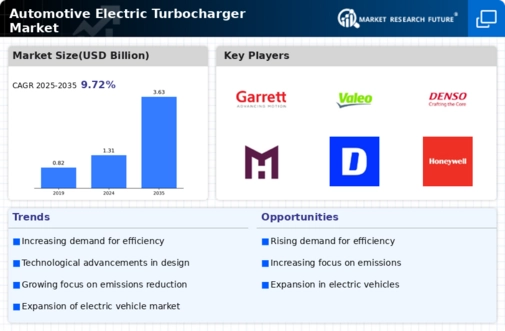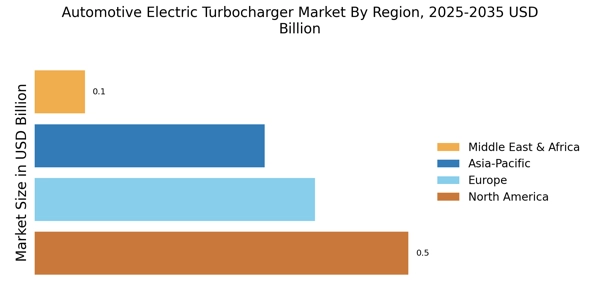Rising Demand for Fuel Efficiency
The Automotive Electric Turbocharger Market is experiencing a notable surge in demand for fuel-efficient vehicles. As consumers become increasingly aware of environmental issues and fuel costs, manufacturers are compelled to innovate. Electric turbochargers enhance engine efficiency by optimizing air intake, which can lead to improved fuel economy. According to recent data, vehicles equipped with electric turbochargers can achieve up to 20% better fuel efficiency compared to traditional turbo systems. This trend is likely to continue as regulatory bodies impose stricter emissions standards, pushing automakers to adopt technologies that reduce fuel consumption and emissions. Consequently, the Automotive Electric Turbocharger Market is poised for growth as it aligns with consumer preferences and regulatory requirements.
Technological Innovations in Turbocharging
Technological advancements are a driving force in the Automotive Electric Turbocharger Market. Innovations in electric motor technology and materials science have led to the development of more efficient and compact turbochargers. These advancements allow for quicker spool-up times and improved performance across various engine types. For instance, the integration of advanced sensors and control systems enables real-time adjustments to boost pressure, enhancing engine responsiveness. Market data indicates that the adoption of electric turbochargers is expected to increase by approximately 15% annually over the next five years, reflecting the industry's commitment to innovation. As manufacturers continue to invest in research and development, the Automotive Electric Turbocharger Market is likely to witness a wave of new products that cater to diverse consumer needs.
Regulatory Pressure for Emission Reductions
Regulatory frameworks aimed at reducing vehicle emissions are a critical driver for the Automotive Electric Turbocharger Market. Governments worldwide are implementing stringent emissions standards, compelling automakers to adopt cleaner technologies. Electric turbochargers play a vital role in meeting these regulations by improving engine efficiency and reducing harmful emissions. For example, the introduction of the Euro 7 standards in Europe is expected to accelerate the adoption of advanced turbocharging technologies. Market analysts suggest that compliance with these regulations could lead to a 30% increase in the use of electric turbochargers in new vehicle models. As manufacturers strive to meet these evolving standards, the Automotive Electric Turbocharger Market is likely to experience robust growth.
Consumer Preference for Performance and Power
Consumer preferences are shifting towards vehicles that offer enhanced performance and power, which is a significant driver for the Automotive Electric Turbocharger Market. As drivers seek more dynamic driving experiences, the demand for technologies that provide instant power delivery is increasing. Electric turbochargers can deliver boost on demand, improving acceleration and overall vehicle responsiveness. Market Research Future indicates that vehicles equipped with electric turbochargers are perceived as more powerful and efficient, leading to higher consumer satisfaction. This trend is expected to continue, with a projected increase in the market share of electric turbochargers in performance-oriented vehicles. As automakers respond to these consumer demands, the Automotive Electric Turbocharger Market is likely to expand, driven by the desire for enhanced driving experiences.
Growth of Electric and Hybrid Vehicle Segments
The Automotive Electric Turbocharger Market is significantly influenced by the growth of electric and hybrid vehicle segments. As these vehicles gain traction, the demand for components that enhance performance and efficiency becomes paramount. Electric turbochargers are particularly well-suited for hybrid applications, where they can provide additional power without compromising fuel efficiency. Recent statistics show that the hybrid vehicle market is projected to grow at a compound annual growth rate of 25% over the next five years. This growth is likely to drive the adoption of electric turbochargers, as manufacturers seek to optimize the performance of their hybrid offerings. Consequently, the Automotive Electric Turbocharger Market stands to benefit from this trend, as it aligns with the broader shift towards electrification in the automotive sector.


















Leave a Comment